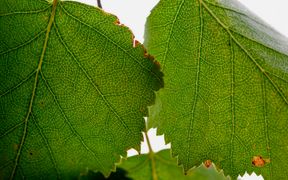A greener route to blue – a new method drastically reduces the amount of solvent needed to produce widely used organic dyes

Organic, or carbon-containing dyes have important roles in nature. For example, they are responsible for transporting oxygen and other gases in the body (as part of haemoglobin) and converting solar energy into chemical energy in photosynthesis (chlorophyll).
One class of artificial organic dyes is phthalocyanines, which are widely applied in industrial processes, sensing, nanomedicine, solar cells and other optoelectronics. However, the production of phthalocyanines is not without its issues, says Eduardo Anaya, Aalto University Academy Research Fellow and one of the main authors of the new study.
‘Phthalocyanines are produced by using a lot of solvents such as dimethylaminoethanol (DMAE). It is corrosive, flammable, bioactive and harmful to the environment.’
Anaya and colleagues at Aalto University have demonstrated how phthalocyanines can be produced in a more environmentally friendly way with solid-state synthesis. Their research, published in the journal Angewandte Chemie International Edition, was categorised as a “hot paper”.
Industry in the European Union alone uses 10,000 tonnes of DMAE per year for many different processes. In this new method introduced by Aalto researchers, the amount of solvent is reduced by over 99%, says postdoctoral researcher Sandra Kaabel, another of the main authors.
The research team used phthalonitrile as the starting material, an organic compound commonly used in the production of dyes. It was first processed with a few drops of DMAE and a zinc template by ball-milling, after which the solid reaction mixture was aged in an oven at 55 °C for a week, or at 100°C for 48 hours.
‘It was fascinating to see how the colour went from white, through green and changed into a deep blue in the oven – you could see with your own eyes how the method works,’ says Kaabel. ‘By solid-state methods we can produce chemicals without needing to dissolve the components of the reaction.’
In the traditional method, a solvent is heated in between 160 to 250°C and the overall yield is fairly low in relation to the materials and time spent. The environmentally-friendly method developed by Aalto researchers boosted the space-time yield four-fold by removing most of the solvent and carrying out the reactions at a lower temperature.

Example from nature, idea brewed over coffee
The molecular structure of phthalocyanine makes it adaptable to a wide range of applications.
‘Nature is an inspiration, having created organic colours for many different purposes over millions of years,’ says Anaya. ‘We can capture them as they are and use colours in artificial photosynthesis to produce energy, for example, or take ideas even further.’
Ideas for new biomaterial solutions are refined at FinnCERES, a competence centre shared by Aalto University and VTT Technical Research Centre of Finland. The research group is working within the FinnCERES project “SolarSafe” to develop cellulosic material that is self-sterilizing through a reaction initiated by a dye and light and could be applied in biomedicine.
Such new ideas are born through encounters, both inside and outside the lab.
‘The idea for our new way to produce dyes also came about from us brainstorming in the coffee room–and then we just started experimenting,’ says Daniel Langerreiter, the first author and a PhD student in the group.
Link to the paper: https://doi.org/10.1002/anie.202209033
FinnCERES - Flagship for boosting bioeconomy
Boosting the world’s bioeconomy by developing new bio-based materials with Aalto University and VTT, companies, and research organizations through a shared passion to create a sustainable future and a belief in innovations based on solid scientific foundations.

Read more news

Future makers research batteries, cryptography and plastic recycling
The Technology Industries of Finland Centennial Foundation awarded 3.5 million euros in research funding to eight projects, five from Aalto University.
The pilot project for direct article delivery from the National Repository Library ends
Aalto University has been participated in the pilot project for direct article delivery with the National Repository Library and Kopiosto from 2023 to 2025. The pilot ends on 19th December.
Meet the new ELLIS Institute PIs: Azade Farshad advances AI for medical applications
Farshad’s research background is in computer vision and generative models.






